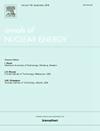Modeling, verification and validation of multiple PWR depletion cycles with DRAGON and PARCS
IF 1.9
3区 工程技术
Q1 NUCLEAR SCIENCE & TECHNOLOGY
引用次数: 0
Abstract
This paper introduces a methodology for modeling Pressurized Water Reactors (PWRs) across multiple depletion cycles using the DRAGON and PARCS codes. The approach incorporates history effects to improve the accuracy of reactor simulations, specifically focusing on the evolution of PWR cores under irradiation. A succint, code-to-code verification of the history effect implementation is performed against the POLARIS/PARCS code system. Subsequently, simulations covering six depletion cycles in three distinct reactors—Fessenheim-2, Almaraz-2, and Turkey-Point-3—are evaluated against experimental data, including primary circuit boron concentration, axial offset, and neutron flux detector responses. The models demonstrate reasonable accuracy in comparison to measurements, highlighting their potential for testing and validating new nuclear data libraries, since all the steps, from ENDF-6 files to the calculations of core-follow parameters are included in the code system.
用DRAGON和PARCS对多个压水堆耗尽循环进行建模、验证和验证
本文介绍了一种使用DRAGON和PARCS代码跨多个耗尽循环对压水堆(PWRs)进行建模的方法。该方法结合了历史效应来提高反应堆模拟的准确性,特别关注了压水堆堆芯在辐照下的演变。针对POLARIS/PARCS代码系统,对历史效果实现进行了简洁的代码对代码验证。随后,在三个不同的反应堆(fessenheim -2、almaraz2和turkey - point -3)中进行了六个耗尽循环的模拟,并根据实验数据进行了评估,包括初级回路硼浓度、轴向偏移和中子通量探测器响应。与测量结果相比,这些模型显示出合理的准确性,突出了它们在测试和验证新核数据库方面的潜力,因为从ENDF-6文件到堆芯跟随参数的计算,所有步骤都包含在代码系统中。
本文章由计算机程序翻译,如有差异,请以英文原文为准。
求助全文
约1分钟内获得全文
求助全文
来源期刊

Annals of Nuclear Energy
工程技术-核科学技术
CiteScore
4.30
自引率
21.10%
发文量
632
审稿时长
7.3 months
期刊介绍:
Annals of Nuclear Energy provides an international medium for the communication of original research, ideas and developments in all areas of the field of nuclear energy science and technology. Its scope embraces nuclear fuel reserves, fuel cycles and cost, materials, processing, system and component technology (fission only), design and optimization, direct conversion of nuclear energy sources, environmental control, reactor physics, heat transfer and fluid dynamics, structural analysis, fuel management, future developments, nuclear fuel and safety, nuclear aerosol, neutron physics, computer technology (both software and hardware), risk assessment, radioactive waste disposal and reactor thermal hydraulics. Papers submitted to Annals need to demonstrate a clear link to nuclear power generation/nuclear engineering. Papers which deal with pure nuclear physics, pure health physics, imaging, or attenuation and shielding properties of concretes and various geological materials are not within the scope of the journal. Also, papers that deal with policy or economics are not within the scope of the journal.
 求助内容:
求助内容: 应助结果提醒方式:
应助结果提醒方式:


